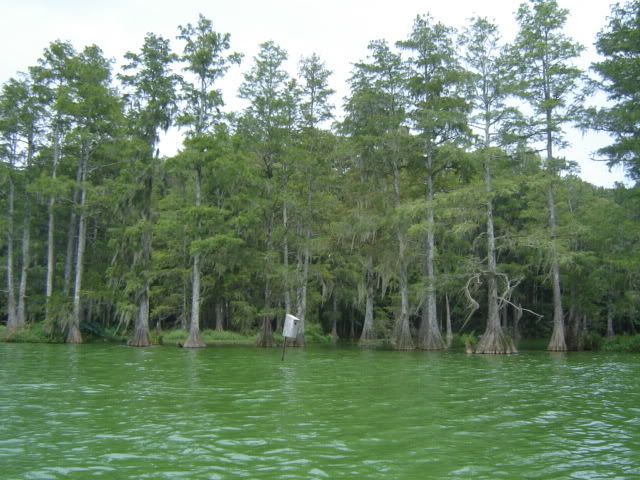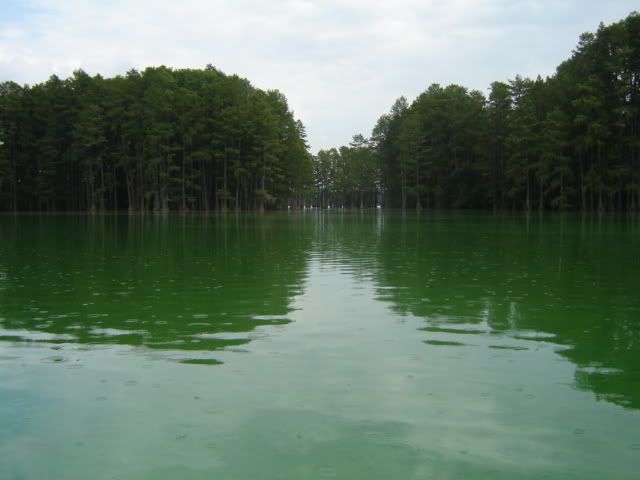Lake Munson
Moderators: bman, Tom Keels, Chalk
-
Mister Mullet
- Posts: 396
- Joined: May 29th, 2007, 10:30 am
Lake Munson
Anybody have information on fishing Lake Munson? Are there bass in it?
- DF 1860DLX
- Posts: 93
- Joined: April 8th, 2007, 7:51 pm
- Location: Tallahassee
Being down stream from the City Of Tallahassee sewage treatment plant spray fields I would be hesitant to eat a fish out of there. That being said- they did testing not to log ago and the fish were fine to eat.
Here is a link to the State Fish Consumption Guidelines...
Also see Below from the Democrat...
Originally published April 19, 2007
PCBs found in some local catfish Officials advise against eating catfish from Lake Munson.
By Bruce Ritchie
DEMOCRAT STAFF WRITER
Print Email to a friend Subscribe
State and local health officials are advising against eating a certain catfish from Lake Munson, but Bud Rogers said that doesn't matter to him.
Rogers, who lives along the shores of Lake Munson, said he doesn't believe half of what he hears from experts. So he's not inclined to do anything different because of the advisory.
ADVERTISEMENT
"If I wanted to fish, I would eat them," Rogers said. But he added that he's given up fishing because he doesn't care to do it any more.
Still, health officials are advising against eating brown bullhead catfish because they found they contain low levels of polychlorinated biphenyls, also known as PCBs. Other fish from the lake are safe to eat.
State health officials eventually may decide on an advisory recommending limited consumption of the brown bullhead catfish, said Joe Sekerke, a toxicologist in the Division of Environmental Health.
PCBs have been used as coolants and lubricants in transformers and other electrical equipment. The manufacture of PCBs was stopped in the U.S. in 1977 because they can cause cancer and can build up in the environment.
Florida Department of Environmental Protection officials said they don't know the source of PCBs in the Lake Munson fish.
The advisory issued Monday is the first for PCB in a Florida waterway, Sekerke said.
Daniel Crews, a neighbor of Rogers on Lake Munson, said he tried to catch fish recently but couldn't get a nibble. After being told of the advisory on brown bullhead catfish, Crews said, "I guess I'm glad I didn't catch any."
Sekerke said he doesn't know how long PCBs have been in the lake because he's not aware of the fish having been tested for it before.
People would be showing other symptoms of liver problems, such as low energy and increases in liver enzymes, Sekerke said. He also said the health limits that the state is considering for fish are very conservative.
"If someone were having health effects from PCBs, they would know about it," Sekerke said.
Finding a source of the contaminant could be very difficult, DEP officials said.
Jerry Brooks, assistant director of department's Division of Water Resources, said additional fish samples should be collected and tested first to ensure the toxic compound is present.
"You wouldn't expect to find PCBs (in fish)," Brooks said. "When you find them, it is typically associated with a spill or a contaminated site that needs to be dealt with."
PCB-contaminated soil was removed last year from the Cascades Park east of Gadsden Street, said Jennette Curtis, project manager for the Cascades Park cleanup. The park was the former site of city utility operations, including an electrical substation.
Stormwater flows from Cascades Park to Lake Munson through St. Augustine Branch and Munson Slough. Neither Curtis nor DEP officials said they know whether the park is a source of contamination.
Lake Munson drains a large portion of the city of Tallahassee including the downtown area. It eventually flows into a sinkhole that contributes flow to Wakulla Springs.
The Florida Fish and Wildlife Conservation Commission tested fish for a wide range of contaminants because some residents said they thought the fish were not safe to eat, said Michael Hill, a fisheries biologist.
He said the testing shows that they're OK, other than the brown bullhead catfish. There are limited consumption advisories for some fish because of mercury.
The lake's pea green color this week was caused by microscopic algae, Hill said.
Stormwater runoff, tainted with fertilizer from lawns, have fueled plant growth in the lake, he said. Now, a foreign species called the channeled apple snail is consuming plants.
But bass, bream and crappie (also known as speckled perch) are thriving in the lake, Hill said.
"I tell folks if they want to catch a big bass, go to Munson," he said.
Contact reporter Bruce Ritchie at (850) 599-2253 or britchie@tallahassee.com.
Here is a link to the State Fish Consumption Guidelines...
Also see Below from the Democrat...
Originally published April 19, 2007
PCBs found in some local catfish Officials advise against eating catfish from Lake Munson.
By Bruce Ritchie
DEMOCRAT STAFF WRITER
Print Email to a friend Subscribe
State and local health officials are advising against eating a certain catfish from Lake Munson, but Bud Rogers said that doesn't matter to him.
Rogers, who lives along the shores of Lake Munson, said he doesn't believe half of what he hears from experts. So he's not inclined to do anything different because of the advisory.
ADVERTISEMENT
"If I wanted to fish, I would eat them," Rogers said. But he added that he's given up fishing because he doesn't care to do it any more.
Still, health officials are advising against eating brown bullhead catfish because they found they contain low levels of polychlorinated biphenyls, also known as PCBs. Other fish from the lake are safe to eat.
State health officials eventually may decide on an advisory recommending limited consumption of the brown bullhead catfish, said Joe Sekerke, a toxicologist in the Division of Environmental Health.
PCBs have been used as coolants and lubricants in transformers and other electrical equipment. The manufacture of PCBs was stopped in the U.S. in 1977 because they can cause cancer and can build up in the environment.
Florida Department of Environmental Protection officials said they don't know the source of PCBs in the Lake Munson fish.
The advisory issued Monday is the first for PCB in a Florida waterway, Sekerke said.
Daniel Crews, a neighbor of Rogers on Lake Munson, said he tried to catch fish recently but couldn't get a nibble. After being told of the advisory on brown bullhead catfish, Crews said, "I guess I'm glad I didn't catch any."
Sekerke said he doesn't know how long PCBs have been in the lake because he's not aware of the fish having been tested for it before.
People would be showing other symptoms of liver problems, such as low energy and increases in liver enzymes, Sekerke said. He also said the health limits that the state is considering for fish are very conservative.
"If someone were having health effects from PCBs, they would know about it," Sekerke said.
Finding a source of the contaminant could be very difficult, DEP officials said.
Jerry Brooks, assistant director of department's Division of Water Resources, said additional fish samples should be collected and tested first to ensure the toxic compound is present.
"You wouldn't expect to find PCBs (in fish)," Brooks said. "When you find them, it is typically associated with a spill or a contaminated site that needs to be dealt with."
PCB-contaminated soil was removed last year from the Cascades Park east of Gadsden Street, said Jennette Curtis, project manager for the Cascades Park cleanup. The park was the former site of city utility operations, including an electrical substation.
Stormwater flows from Cascades Park to Lake Munson through St. Augustine Branch and Munson Slough. Neither Curtis nor DEP officials said they know whether the park is a source of contamination.
Lake Munson drains a large portion of the city of Tallahassee including the downtown area. It eventually flows into a sinkhole that contributes flow to Wakulla Springs.
The Florida Fish and Wildlife Conservation Commission tested fish for a wide range of contaminants because some residents said they thought the fish were not safe to eat, said Michael Hill, a fisheries biologist.
He said the testing shows that they're OK, other than the brown bullhead catfish. There are limited consumption advisories for some fish because of mercury.
The lake's pea green color this week was caused by microscopic algae, Hill said.
Stormwater runoff, tainted with fertilizer from lawns, have fueled plant growth in the lake, he said. Now, a foreign species called the channeled apple snail is consuming plants.
But bass, bream and crappie (also known as speckled perch) are thriving in the lake, Hill said.
"I tell folks if they want to catch a big bass, go to Munson," he said.
Contact reporter Bruce Ritchie at (850) 599-2253 or britchie@tallahassee.com.
Barry Bevis, Realtor and Owner of BigBendFishing.net
I liked it so much, I bought the company
http://www.bevisrealty.com

TEAM "Duck Season!"
I liked it so much, I bought the company
http://www.bevisrealty.com

TEAM "Duck Season!"
I got enough honey-dos finished to slip out for a little while yesterday afternoon and check out Lake Munson. I put in about 4 p.m. and fished for about 90 minutes before the weather and the skeeters chased me off the lake.
Good news is that the three bass I caught were fat and sassy. Bad news is that the deepest water is only about three feet deep and the bottom is so thick with muck that it was hard to get a decent reading on the depth finder. There was also a substantial algae bloom on the water.
I was amazed to find a couple of guys on jet skis just taking out as I got there. I think that is about the last place I would want to get in the water.
The cypress trees around the edge of the lake were in less than a foot of water but the high water marks on the trunks make it appear that, when the water is back up, they could be a lot of fun to fish around. There were also a lot of schools of baitfish on the surface but I never saw any bass hitting them.
All three of my fish came on a white, 3/8 oz willowleaf spinnerbait. They were holding tight to cover in the middle of the lake. The three fish went six, four and two pounds.
The boat ramp is especially nice with siping cut into it to help with tow vehicle traction.
Good news is that the three bass I caught were fat and sassy. Bad news is that the deepest water is only about three feet deep and the bottom is so thick with muck that it was hard to get a decent reading on the depth finder. There was also a substantial algae bloom on the water.
I was amazed to find a couple of guys on jet skis just taking out as I got there. I think that is about the last place I would want to get in the water.
The cypress trees around the edge of the lake were in less than a foot of water but the high water marks on the trunks make it appear that, when the water is back up, they could be a lot of fun to fish around. There were also a lot of schools of baitfish on the surface but I never saw any bass hitting them.
All three of my fish came on a white, 3/8 oz willowleaf spinnerbait. They were holding tight to cover in the middle of the lake. The three fish went six, four and two pounds.
The boat ramp is especially nice with siping cut into it to help with tow vehicle traction.

- MrGreenJeans
- Posts: 122
- Joined: June 5th, 2007, 3:32 pm
- Location: Havana,Fl


